The Response of Carbon Storage to Multi-Objective Land Use/Cover Spatial Optimization and Vulnerability Assessment
Abstract
:1. Introduction
2. Materials and Methods
2.1. Study Area
2.2. Data Sources and Data Processing
2.3. LULC Optimization–Carbon Storage Simulation–Vulnerability Assessment Framework
- (i)
- Calculation of historical LULC and simulation of carbon storage. Based on the LULC data and carbon density data from 1985, 1990, 2000, 2010, and 2020, the InVEST model was used to analyze the changes in carbon storage in the YRB from 1985 to 2020.
- (ii)
- Prediction of future LULC distribution and simulation of carbon storage. Based on the LULC data from 2010 and 2020 and 22 given factors (natural and socio-economic factors), the MOP-PLUS model was used to conduct an optimization study on LULC expansion in the YRB. Subsequently, based on carbon density data, the InVEST model was employed to analyze the changes in carbon storage in the YRB.
- (iii)
- Ecosystem carbon storage service vulnerability assessment. The vulnerability of ecosystem carbon storage services in the YRB was assessed using the PII based on LULC change and carbon storage change.
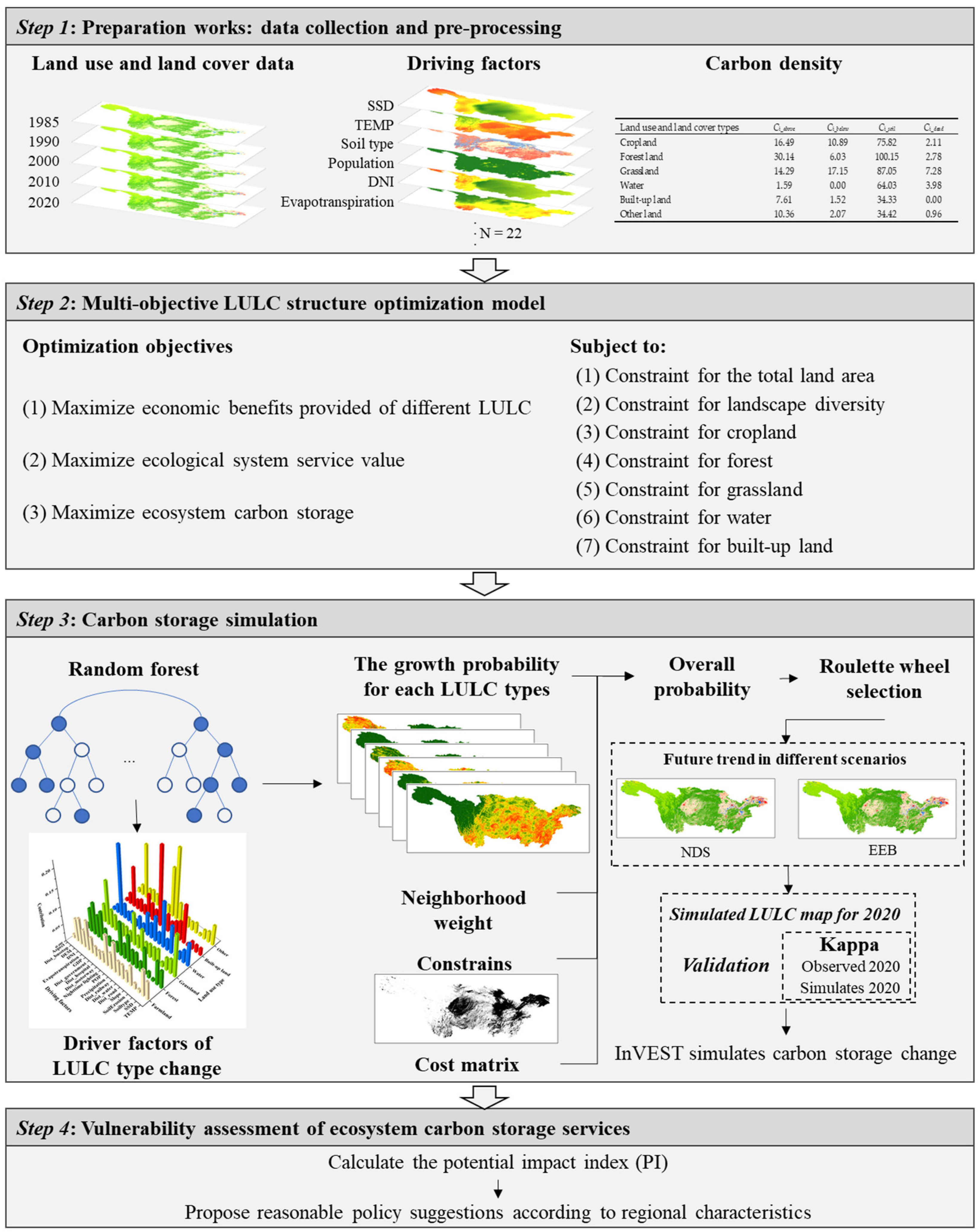
2.4. Multi-Objective LULC Structure Optimization Model
- (1)
- Maximize the economic benefits provided by different LULCs as follows:where f1(x) is economic benefit; cj represents economic benefit per unit area; and xj is the area of different LULC types (j = 1, 2, 3, 4, 5, and 6 denotes cropland, forest, grassland, water, built-up land, and other land, respectively).
- (2)
- Maximize ecological system service value as follows:where f2(x) is the ecological ecosystem service value and dj represents the ESV per unit area.
- (3)
- Maximize ecosystem carbon storage as follows:where f3(x) denotes the maximization of ecosystem carbon storage; Cj_value denotes the total carbon intensity of the j-th LULC types; and xj0 is the initial class j LULC area.
- (1)
- Constraint for the total land area: the sum of the area of each LULC type should equal the total area:where SA is the total study area.
- (2)
- Constraints for landscape diversity: grassland and other land are frequently reclaimed for forest or built-up land development. In order to maintain the diversity of the landscape and to allow space for urban development, it is assumed that grassland and other land will make up at least 1% of the total LULC area.
- (3)
- Constraint for cropland: cropland area should be equal to or greater than the average decline in the historical LULC data and less than or equal to the largest area during the planning period:where represents the average rate of change in the area of cropland; x10 is the initial cropland area; and x1t represents the historical cropland area at time t.
- (4)
- Constraint for forests: the share of forest cover is calculated on the basis of the “ecological green equivalent”, i.e., the “amount of green” that ensures homogenous photosynthesis and provides quantitative forest ecological functions. In the land system, the LULC types that would satisfy the green equivalent include cropland, forest, and grassland, and the forest area should exceed the natural development scenario:where denotes the cropland green equivalent coefficient; is the forest green equivalent coefficient; represents the grassland green equivalent coefficient; and PND denotes the forest area coefficient under the natural development projection.
- (5)
- Constraint for grassland: a large amount of grassland has been converted into built-up land and water bodies since the 1990s. Here, the maximum value based on historical data is used as the upper limit of grassland area:where x3t represents the historical grassland area at time t.
- (6)
- Constraint for water: over the past few decades, large water areas have been used for built-up land and crop production. Therefore, in order to enhance water resource protection, the decreasing trend in watershed area would decelerate as follows:where represents the mean rate of water area change.
- (7)
- Constraint for built-up land: based on the current growth trend, the built-up area in the future is expected to exceed the current area and is projected to be the current area plus the average increase during the planning period:where represents the mean rate of built-up land area change.
2.5. InVEST Simulates Carbon Storage Change
2.6. PLUS Simulates Future LULC Dynamics
2.7. Vulnerability Assessment of Ecosystem Carbon Storage Services
2.8. Scenario Design
3. Results
3.1. Impact of LULC on Carbon Storage from 1985 to 2020
3.1.1. Dynamics of LULC Changes from 1985 to 2020
3.1.2. Driver Factors of LULC-Type Change
3.1.3. Carbon Storage Dynamics from 1985 to 2020
3.2. Assessment of Carbon Storage Characterization
3.2.1. LULC Future Scenario Simulation
3.2.2. Carbon Storage Dynamics from 2020 to 2030
3.2.3. Spatial Autocorrelation Assessment of Carbon Storage
3.3. Vulnerability Analysis of Ecosystem Carbon Storage Services
4. Discussion
4.1. Contributions of Drivers to Changes in LULC
4.2. Response of Carbon Storage to LULC
4.3. Ecosystem Service Vulnerability
4.4. Limitations and Future Perspective
5. Conclusions
Author Contributions
Funding
Institutional Review Board Statement
Informed Consent Statement
Data Availability Statement
Acknowledgments
Conflicts of Interest
References
- Atwood, T.B.; Connolly, R.M.; Almahasheer, H.; Carnell, P.E.; Duarte, C.M.; Ewers Lewis, C.J.; Irigoien, X.; Kelleway, J.J.; Lavery, P.S.; Macreadie, P.I.; et al. Global patterns in mangrove soil carbon stocks and losses. Nat. Clim. Change 2017, 7, 523–528. [Google Scholar] [CrossRef]
- Lal, R. Sequestration of atmospheric CO2 in global carbon pools. Energy Environ. Sci. 2008, 1, 86–100. [Google Scholar] [CrossRef]
- Deng, J.S.; Wang, K.; Hong, Y.; Qi, J.G. Spatio-temporal dynamics and evolution of land use change and landscape pattern in response to rapid urbanization. Landsc. Urban Plan. 2009, 92, 187–198. [Google Scholar] [CrossRef]
- Pereira, P. Ecosystem services in a changing environment. Sci. Total Environ. 2020, 702, 135008. [Google Scholar] [CrossRef] [PubMed]
- Xystrakis, F.; Psarras, T.; Koutsias, N. A process-based land use/land cover change assessment on a mountainous area of Greece during 1945–2009, Signs of socio-economic drivers. Sci. Total Environ. 2017, 587, 360–370. [Google Scholar] [CrossRef] [PubMed]
- Gomes, E.; Inácio, M.; Bogdzevič, K.; Kalinauskas, M.; Karnauskaitė, D.; Pereira, P. Future land-use changes and its impacts on terrestrial ecosystem services: A review. Sci. Total Environ. 2021, 781, 146716. [Google Scholar] [CrossRef] [PubMed]
- Zhu, L.; Song, R.; Sun, S.; Li, Y.; Hu, K. Land use/land cover change and its impact on ecosystem carbon storage in coastal areas of China from 1980 to 2050. Ecol. Indic. 2022, 142, 109178. [Google Scholar] [CrossRef]
- Dampha, N.K. Change detection (1985–2020): Projections on land-use land cover, carbon storage, sequestration, and valuation in Southwestern Gambia. Sustain. Environ. 2021, 7, 1875556. [Google Scholar] [CrossRef]
- Ren, Y.; Wei, X.; Wei, X.; Pan, J.; Xie, P.; Song, X.; Peng, D.; Zhao, J. Relationship between vegetation carbon storage and urbanization: A case study of Xiamen, China. For. Ecol. Manag. 2011, 261, 1214–1223. [Google Scholar] [CrossRef]
- Sohl, T.L.; Sleeter, B.M.; Zhu, Z.; Sayler, K.L.; Bennett, S.; Bouchard, M.; Reker, R.; Hawbaker, T.; Wein, A.; Liu, S.; et al. A land-use and land-cover modeling strategy to support a national assessment of carbon stocks and fluxes. Appl. Geogr. 2012, 34, 111–124. [Google Scholar] [CrossRef]
- Eslamdoust, J.; Sohrabi, H. Carbon storage in biomass, litter, and soil of different native and introduced fast-growing tree plantations in the South Caspian Sea. J. For. Res. 2018, 29, 449–457. [Google Scholar] [CrossRef]
- Zhong, H.S.; Wang, H.; Deng, Y.H.; Chen, M.C.; Peng, L.C.; Luo, Y.H.; Qin, J.; Wu, D.; Ding, X.; Hu, Y.; et al. Quantum computational advantage using photons. Science 2020, 370, 1460–1463. [Google Scholar] [CrossRef] [PubMed]
- Delphin, S.; Escobedo, F.J.; Abd-Elrahman, A.; Cropper, W.P. Urbanization as a land use change driver of forest ecosystem services. Land Use Policy 2016, 54, 188–199. [Google Scholar] [CrossRef]
- He, C.; Zhang, D.; Huang, Q.; Zhao, Y. Assessing the potential impacts of urban expansion on regional carbon storage by linking the LUSD-urban and InVEST models. Environ. Model. Softw. 2016, 75, 44–58. [Google Scholar] [CrossRef]
- Babbar, D.; Areendran, G.; Sahana, M.; Sarma, K.; Raj, K.; Sivadas, A. Assessment and prediction of carbon sequestration using Markov chain and InVEST model in Sariska Tiger Reserve, India. J. Clean. Prod. 2021, 278, 123333. [Google Scholar] [CrossRef]
- Jiang, W.; Deng, Y.; Tang, Z.; Lei, X.; Chen, Z. Modelling the potential impacts of urban ecosystem changes on carbon storage under different scenarios by linking the CLUE-S and the InVEST models. Ecol. Model. 2017, 345, 30–40. [Google Scholar] [CrossRef]
- Zhao, M.; He, Z.; Du, J.; Chen, L.; Lin, P.; Fang, S. Assessing the effects of ecological engineering on carbon storage by linking the CA-Markov and InVEST models. Ecol. Indic. 2019, 98, 29–38. [Google Scholar] [CrossRef]
- Yang, H.; Huang, J.; Liu, D. Linking climate change and socioeconomic development to urban land use simulation: Analysis of their concurrent effects on carbon storage. Appl. Geogr. 2020, 115, 102135. [Google Scholar] [CrossRef]
- Gong, J.; Liu, D.; Zhang, J.; Xie, Y.; Cao, E.; Li, H. Tradeoffs/synergies of multiple ecosystem services based on land use simulation in a mountain-basin area, western China. Ecol. Indic. 2019, 99, 283–293. [Google Scholar] [CrossRef]
- Wang, X.; Shen, Y.; Su, C. Spatial-temporal evolution and driving factors of carbon emission efficiency of cities in the Yellow River Basin. Energy Rep. 2023, 9, 1065–1070. [Google Scholar] [CrossRef]
- Sun, W.; Ding, X.; Su, J.; Mu, X.; Zhang, Y.; Gao, P.; Zhao, G. Land use and cover changes on the Loess Plateau: A comparison of six global or national land use and cover datasets. Land Use Policy 2022, 119, 106165. [Google Scholar] [CrossRef]
- Adhami, M.; Sadeghi, S.H.; Sheikhmohammady, M. Making competent land use policy using a co-management framework. Land Use Policy 2018, 72, 171–180. [Google Scholar] [CrossRef]
- Ghorbanian, A.; Kakooei, M.; Amani, M.; Mahdavi, S.; Mohammadzadeh, A.; Hasanlou, M. Improved land cover map of Iran using Sentinel imagery within Google Earth Engine and a novel automatic workflow for land cover classification using migrated training samples. ISPRS J. Photogramm. Remote Sens. 2020, 167, 276–288. [Google Scholar] [CrossRef]
- Seidl, R.; Schelhaas, M.J.; Rammer, W.; Verkerk, P.J. Increasing forest disturbances in Europe and their impact on carbon storage. Nat. Clim. Change 2014, 4, 806–810. [Google Scholar] [CrossRef] [PubMed]
- Hungate, B.A.; Barbier, E.B.; Ando, A.W.; Marks, S.P.; Reich, P.B.; Van Gestel, N.; Tilman, D.; Knops, J.M.; Hooper, D.U.; Butterfield, B.J.; et al. The economic value of grassland species for carbon storage. Sci. Adv. 2017, 3, e1601880. [Google Scholar] [CrossRef] [PubMed]
- Jerray, A.; Rumpel, C.; Le Roux, X.; Massad, R.S.; Chabbi, A. N2O emissions from cropland and grassland management systems are determined by soil organic matter quality and soil physical parameters rather than carbon stock and denitrifier abundances. Soil Biol. Biochem. 2024, 190, 109274. [Google Scholar] [CrossRef]
- Moges, D.M.; Bhat, H.G. Integration of geospatial technologies with RUSLE for analysis of land use/cover change impact on soil erosion: Case study in Rib watershed, north-western highland Ethiopia. Environ. Earth Sci. 2017, 76, 1–4. [Google Scholar] [CrossRef]
- Gao, Y.; Jia, J.; Lu, Y.; Sun, X.; Wen, X.; He, N.; Yang, T. Progress in watershed geography in the Yangtze River Basin and the affiliated ecological security perspective in the past 20 years, China. J. Geogr. Sci. 2020, 30, 867–880. [Google Scholar] [CrossRef]
- Li, Z.; Sun, X.; Huang, Z.; Zhang, X.; Wang, Z.; Li, S.; Zheng, W.; Zhai, B. Changes in nutrient balance, environmental effects, and green development after returning farmland to forests: A case study in Ningxia, China. Sci. Total Environ. 2020, 735, 139370. [Google Scholar] [CrossRef]
- Myllyvirta, L.; Zhang, S.; Shen, X.; Bi, Y. Political Economy of Climate and Clean Energy in China; Heinrich Böll Foundation: Berlin, Germany, 2020; 38p, Available online: https://reglobal.org/wp-content/uploads/2021/02/Political-Economy-of-Climate-and-Clean-Energy-in-China.pdf (accessed on 19 June 2023).
- Pan, Z.; Gao, G.; Fu, B.; Liu, S.; Wang, J.; He, J.; Liu, D. Exploring the historical and future spatial interaction relationship between urbanization and ecosystem services in the Yangtze River Basin, China. J. Clean. Prod. 2023, 428, 139401. [Google Scholar] [CrossRef]
- Yang, Y.; Lu, H.; Liang, D.; Chen, Y.; Tian, P.; Xia, J.; Wang, H.; Lei, X. Ecological sustainability and its driving factor of urban agglomerations in the Yangtze River Economic Belt based on three-dimensional ecological footprint analysis. J. Clean. Prod. 2022, 330, 129802. [Google Scholar] [CrossRef]
- Ye, X.C.; Liu, F.H.; Zhang, Z.X.; Xu, C.Y.; Liu, J. Spatio-temporal variations of vegetation carbon use efficiency and potential driving meteorological factors in the Yangtze River Basin. J. Mt. Sci. 2020, 17, 1959–1973. [Google Scholar] [CrossRef]
- Kong, R.; Zhang, Z.; Zhang, F.; Tian, J.; Zhu, B.; Zhu, M.; Wang, Y. Spatial and temporal dynamics of forest carbon storage and its driving factors in the Yangtze River Basin. Res. Soil Water Conserv. 2020, 27, 60–66. [Google Scholar] [CrossRef]
- Jia, S. Carbon storage distribution and its dynamic changes of forest vegetation in Yangtze River Basin based on continuous forest resources inventory. J. Ecol. Rural. Environ. 2018, 34, 997–1002. [Google Scholar]
- Xie, T.; Wang, M.; Jiang, R.; Li, L.; Chen, X.; Sarvajayakesavalu, S.; Chen, W. Comparative study on anthropogenic impacts on soil PAHs: Accumulation and source apportionment in tourist and industrial cities in Hebei Province, China. Sci. Total Environ. 2024, 912, 168435. [Google Scholar] [CrossRef] [PubMed]
- Alam, S.A.; Starr, M.; Clark, B.J. Tree biomass and soil organic carbon densities across the Sudanese woodland savannah: A regional carbon sequestration study. J. Arid. Environ. 2013, 89, 67–76. [Google Scholar] [CrossRef]
- Giardina, C.P.; Ryan, M.G. Evidence that decomposition rates of organic carbon in mineral soil do not vary with temperature. Nature 2000, 404, 858–861. [Google Scholar] [CrossRef]
- Chen, G.S.; Yang, Y.S.; Xie, J.S.; Du, Z.; Zhang, J. Total belowground carbon allocation in China’s forests. Acta Ecol. Sin. 2007, 27, 5148–5157. Available online: http://refhub.elsevier.com/S1470-160X(21)01164-X/h0020 (accessed on 19 June 2023).
- Li, X.; Fu, J.; Jiang, D.; Lin, G.; Cao, C. Land use optimization in Ningbo City with a coupled GA and PLUS model. J. Clean. Prod. 2022, 375, 134004. [Google Scholar] [CrossRef]
- Luo, C.; Fang, Z.; Liu, J.; Han, F.; Wu, Y.; Bing, H.; Zhao, P. Root carbon and soil temperature may be key drivers of below-ground biomass in grassland following prescribed fires in autumn and spring. J. Environ. Manag. 2024, 349, 119337. [Google Scholar] [CrossRef]
- Liang, X.; Guan, Q.; Clarke, K.C.; Liu, S.; Wang, B.; Yao, Y. Understanding the drivers of sustainable land expansion using a patch-generating land use simulation (PLUS) model: A case study in Wuhan, China. Comput. Environ. Urban Syst. 2021, 85, 101569. [Google Scholar] [CrossRef]
- IPCC. Impacts, adaptation and vulnerability. In Part A: Global and Sectoral Aspects; Contribution of Working Group II to the Fifth Assessment Report of the Intergovernmental Panel on Climate Change; IPCC: Geneva, Switzerland, 2014; p. 1132. [Google Scholar]
- Schröter, D.; Cramer, W.; Leemans, R.; Prentice, I.C.; Araújo, M.B.; Arnell, N.W.; Bondeau, A.; Bugmann, H.; Carter, T.R.; Gracia, C.A.; et al. Ecosystem service supply and vulnerability to global change in Europe. Science 2005, 310, 1333–1337. [Google Scholar] [CrossRef] [PubMed]
- Metzger, M.J.; Rounsevell, M.D.; Acosta-Michlik, L.; Leemans, R.; Schröter, D. The vulnerability of ecosystem services to land use change. Agric. Ecosyst. Environ. 2006, 114, 69–85. [Google Scholar] [CrossRef]
- Peng, H.; Xia, H.; Shi, Q.; Tang, Z.; Chen, H. Monitoring of wetland cover changes in protected areas to trade-offs between ecological conservation and food security: A case study from the Dongting Lake, China. Ecol. Inform. 2023, 78, 102338. [Google Scholar] [CrossRef]
- Wang, X.; Shi, S.; Zhao, X.; Hu, Z.; Hou, M.; Xu, L. Detecting spatially non-stationary between vegetation and related factors in the Yellow River Basin from 1986 to 2021 using multiscale geographically weighted regression based on Landsat. Remote Sens. 2022, 14, 6276. [Google Scholar] [CrossRef]
- Shen, Q.; Chen, Q.; Tang, B.S.; Yeung, S.; Hu, Y.; Cheung, G. A system dynamics model for the sustainable land use planning and development. Habitat Int. 2009, 33, 15–25. [Google Scholar] [CrossRef]
- Zhao, J.; Liu, S.; Wang, Z.; Gao, H.; Feng, S.; Wei, B.; Hou, Z.; Xiao, F.; Jing, L.; Liao, X. The Impact of Land Use and Landscape Pattern on Ecosystem Services in the Dongting Lake Region, China. Remote Sens. 2023, 15, 2228. [Google Scholar] [CrossRef]
- Hu, J.X.; Le, X.W.; Xu, Y. Estimating terrestrial eco-system carbon stock changes caused by multi-scenarios land-use changes based on the FLUS model: A case study of Pingxiang, Jiangxi. Res. Soil Water Conserv. 2024, 31, 299–309. [Google Scholar]
- Zhu, J.; Hu, X.; Xu, W.; Shi, J.; Huang, Y.; Yan, B. Regional Carbon Stock Response to Land Use Structure Change and Multi-Scenario Prediction: A Case Study of Hunan Province, China. Sustainability 2023, 15, 12178. [Google Scholar] [CrossRef]
- Foody, G.M. Explaining the unsuitability of the kappa coefficient in the assessment and comparison of the accuracy of thematic maps obtained by image classification. Remote Sens. Environ. 2020, 239, 111630. [Google Scholar] [CrossRef]
- Viera, A.J.; Garrett, J.M. Understanding interobserver agreement: The kappa statistic. Fam. Med. 2005, 37, 360–363. Available online: http://www1.cs.columbia.edu/~julia/courses/CS6998/Interrater_agreement.Kappa_statistic.pdf (accessed on 11 July 2023). [PubMed]
- Zhang, J.C.; DeAngelis, D.L.; Zhuang, J.Y. Theory and Practice of Soil Loss Control in Eastern China; Springer Science & Business Media: Berlin/Heidelberg, Germany, 2011. [Google Scholar]
- Du, S.; Zhou, Z.; Huang, D.; Zhang, F.; Deng, F.; Yang, Y. The Response of Carbon Stocks to Land Use/Cover Change and a Vulnerability Multi-Scenario Analysis of the Karst Region in Southern China Based on PLUS-InVEST. Forests 2023, 14, 2307. [Google Scholar] [CrossRef]
- Li, C.; Managi, S. Inappropriate nighttime light reduces living comfort. Environ. Pollut. 2023, 334, 122173. [Google Scholar] [CrossRef] [PubMed]
- Fan, L.; Cai, T.; Wen, Q.; Han, J.; Wang, S.; Wang, J.; Yin, C. Scenario simulation of land use change and carbon storage response in Henan Province, China: 1990–2050. Ecol. Indic. 2023, 154, 110660. [Google Scholar] [CrossRef]
- Chen, S.; Yao, S. Identifying the drivers of land expansion and evaluating multi-scenario simulation of land use: A case study of Mashan County, China. Ecol. Inform. 2023, 77, 102201. [Google Scholar] [CrossRef]
- Jiang, P.; Chen, D.; Xiao, J.; Liu, D.; Zhang, X.; Yang, X.; Ai, G. Climate and anthropogenic influences on the spatiotemporal change in degraded grassland in China. Environ. Eng. Sci. 2021, 38, 1065–1077. [Google Scholar] [CrossRef]
- Sliva, L.; Williams, D.D. Buffer zone versus whole catchment approaches to studying land use impact on river water quality. Water Res. 2001, 35, 3462–3472. [Google Scholar] [CrossRef]
- Wu, J.; Luo, J.; Zhang, H.; Qin, S.; Yu, M. Projections of land use change and habitat quality assessment by coupling climate change and development patterns. Sci. Total Environ. 2022, 847, 157491. [Google Scholar] [CrossRef]
- Phat, N.K.; Knorr, W.; Kim, S. Appropriate measures for conservation of terrestrial carbon stocks—Analysis of trends of forest management in Southeast Asia. For. Ecol. Manag. 2004, 191, 283–299. [Google Scholar] [CrossRef]
- Keith, H.; Mackey, B.G.; Lindenmayer, D.B. Re-evaluation of forest biomass carbon stocks and lessons from the world’s most carbon-dense forests. Proc. Natl. Acad. Sci. USA 2009, 106, 11635–11640. [Google Scholar] [CrossRef]
- Watson, J.E.M.; Evans, T.; Venter, O.; Williams, B.; Tulloch, A.; Stewart, C.; Thompson, I.; Ray, J.C.; Murray, K.; Salazar, A.; et al. The exceptional value of intact forest ecosystems. Nat. Ecol. Evol. 2018, 2, 599–610. [Google Scholar] [CrossRef] [PubMed]
- Koga, N.; Shimoda, S.; Shirato, Y.; Kusaba, T.; Shima, T.; Niimi, H.; Yamane, T.; Wakabayashi, K.; Niwa, K.; Kohyama, K.; et al. Assessing changes in soil carbon stocks after land use conversion from forest land to agricultural land in Japan. Geoderma 2020, 377, 114487. [Google Scholar] [CrossRef]
- Robinson, D.T.; Zhang, J.; MacDonald, D.; Samson, C. Estimating Settlement carbon stock and density using an inventory approach and quantifying their variation by land use and parcel size. Urban For. Urban Green. 2023, 82, 127878. [Google Scholar] [CrossRef]
- Tong, X.; Brandt, M.; Yue, Y.; Horion, S.; Wang, K.; Keersmaecker, W.D.; Tian, F.; Schurgers, G.; Xiao, X.; Luo, Y.; et al. Increased vegetation growth and carbon stock in China karst via ecological engineering. Nat. Sustain. 2018, 1, 44–50. [Google Scholar] [CrossRef]
- Qiu, S.; Peng, J.; Zheng, H.; Xu, Z.; Meersmans, J. How can massive ecological restoration programs interplay with social-ecological systems? A review of research in the South China karst region. Sci. Total Environ. 2022, 807, 150723. [Google Scholar] [CrossRef]
- Zhu, E.; Deng, J.; Zhou, M.; Gan, M.; Jiang, R.; Wang, K.; Shahtahmassebi, A. Carbon emissions induced by land-use and land-cover change from 1970 to 2010 in Zhejiang, China. Sci. Total Environ. 2019, 646, 930–939. [Google Scholar] [CrossRef] [PubMed]
- Gao, Y.; Wang, Z.; Xu, F. Geospatial characteristics and the application of land use functions in the Yangtze River Economic Belt, China: Perspectives on provinces and urban agglomerations. Ecol. Indic. 2023, 155, 110969. [Google Scholar] [CrossRef]
- Wang, Y.; Liang, D.; Wang, J.; Zhang, Y.; Chen, F.; Ma, X. An analysis of regional carbon stock response under land use structure change and multi-scenario prediction, a case study of Hefei, China. Ecol. Indic. 2023, 151, 110293. [Google Scholar] [CrossRef]
- Kong, R.; Zhang, Z.; Zhang, F.; Tian, J.; Chang, J.; Jiang, S.; Zhu, B.; Chen, X. Increasing carbon storage in subtropical forests over the Yangtze River basin and its relations to the major ecological projects. Sci. Total Environ. 2020, 709, 136163. [Google Scholar] [CrossRef]
- Fang, K.; Tang, Y.; Zhang, Q.; Song, J.; Wen, Q.; Sun, H.; Ji, C.; Xu, A. Will China peak its energy-related carbon emissions by 2030? Lessons from 30 Chinese provinces. Appl. Energy 2019, 255, 113852. [Google Scholar] [CrossRef]
- Yang, Q.; Guo, S.; Yuan, W.H.; Shen, Q.; Chen, Y.Q.; Wang, X.H.; Wu, T.H.; Chen, Z.M.; Alsaedi, A.; Hayat, T. Energy-dominated carbon metabolism: A case study of Hubei province, China. Ecol. Inform. 2015, 26, 85–92. [Google Scholar] [CrossRef]
- Zheng, H.; Zhuo, Y.; Xu, Z.; Wu, C.; Huang, J.; Fu, Q. Measuring and characterizing land use mix patterns of China’s megacities: A case study of Shanghai. Growth Change 2021, 52, 2509–2539. [Google Scholar] [CrossRef]
- Fu, Y.; Zhou, T.; Yao, Y.; Qiu, A.; Wei, F.; Liu, J.; Liu, T. Evaluating efficiency and order of urban land use structure: An empirical study of cities in Jiangsu, China. J. Clean. Prod. 2021, 283, 124638. [Google Scholar] [CrossRef]
- Song, R.; Li, X. Urban Human Settlement Vulnerability Evolution and Mechanisms: The Case of Anhui Province, China. Land 2023, 12, 994. [Google Scholar] [CrossRef]
- Cai, W.; Peng, W. Exploring spatiotemporal variation of carbon storage driven by land use policy in the Yangtze River Delta Region. Land 2021, 10, 1120. [Google Scholar] [CrossRef]
- He, N.; Zhou, Y.; Wang, L.; Li, Q.; Zuo, Q.; Liu, J. Spatiotemporal differentiation and the coupling analysis of ecosystem service value with land use change in Hubei Province, China. Ecol. Indic. 2022, 145, 109693. [Google Scholar] [CrossRef]
- Zhou, Y.; Li, X.; Liu, Y. Cultivated land protection and rational use in China. Land Use Policy 2021, 106, 105454. [Google Scholar] [CrossRef]
- Liu, C.; Deng, C.; Li, Z.; Liu, Y. Response characteristics of Soil Erosion to Spatial Conflict in the Production-Living-Ecological Space and Their Drivingmechanism: A Case Study of Dongting Lake Basin in China. Land 2022, 11, 1794. [Google Scholar] [CrossRef]
- Li, W.; Wang, W.; Chen, J.; Zhang, Z. Assessing effects of the Returning Farmland to Forest Program on vegetation cover changes at multiple spatial scales: The case of northwest Yunnan, China. J. Environ. Manag. 2022, 304, 114303. [Google Scholar] [CrossRef]
- Hou, W.; Gao, J.; Wu, S.; Dai, E. Interannual variations in growing-season NDVI and its correlation with climate variables in the southwestern karst region of China. Remote Sens. 2015, 7, 11105–11124. [Google Scholar] [CrossRef]
- Zhang, M.; Wang, K.; Liu, H.; Zhang, C.; Yue, Y.; Qi, X. Effect of ecological engineering projects on ecosystem services in a karst region: A case study of northwest Guangxi, China. J. Clean. Prod. 2018, 183, 831–842. [Google Scholar] [CrossRef]
- Pellikka, P.K.; Heikinheimo, V.; Hietanen, J.; Schäfer, E.; Siljander, M.; Heiskanen, J. Impact of land cover change on aboveground carbon stocks in Afromontane landscape in Kenya. Appl. Geogr. 2018, 94, 178–189. [Google Scholar] [CrossRef]
- Li, Z.T.; Li, M.; Xia, B.C. Spatio-temporal dynamics of ecological security pattern of the Pearl River Delta urban agglomeration based on LUCC simulation. Ecol. Indic. 2020, 114, 106319. [Google Scholar] [CrossRef]
- Li, L.; Song, Y.; Wei, X.; Dong, J. Exploring the impacts of urban growth on carbon storage under integrated spatial regulation: A case study of Wuhan, China. Ecol. Indic. 2020, 111, 106064. [Google Scholar] [CrossRef]
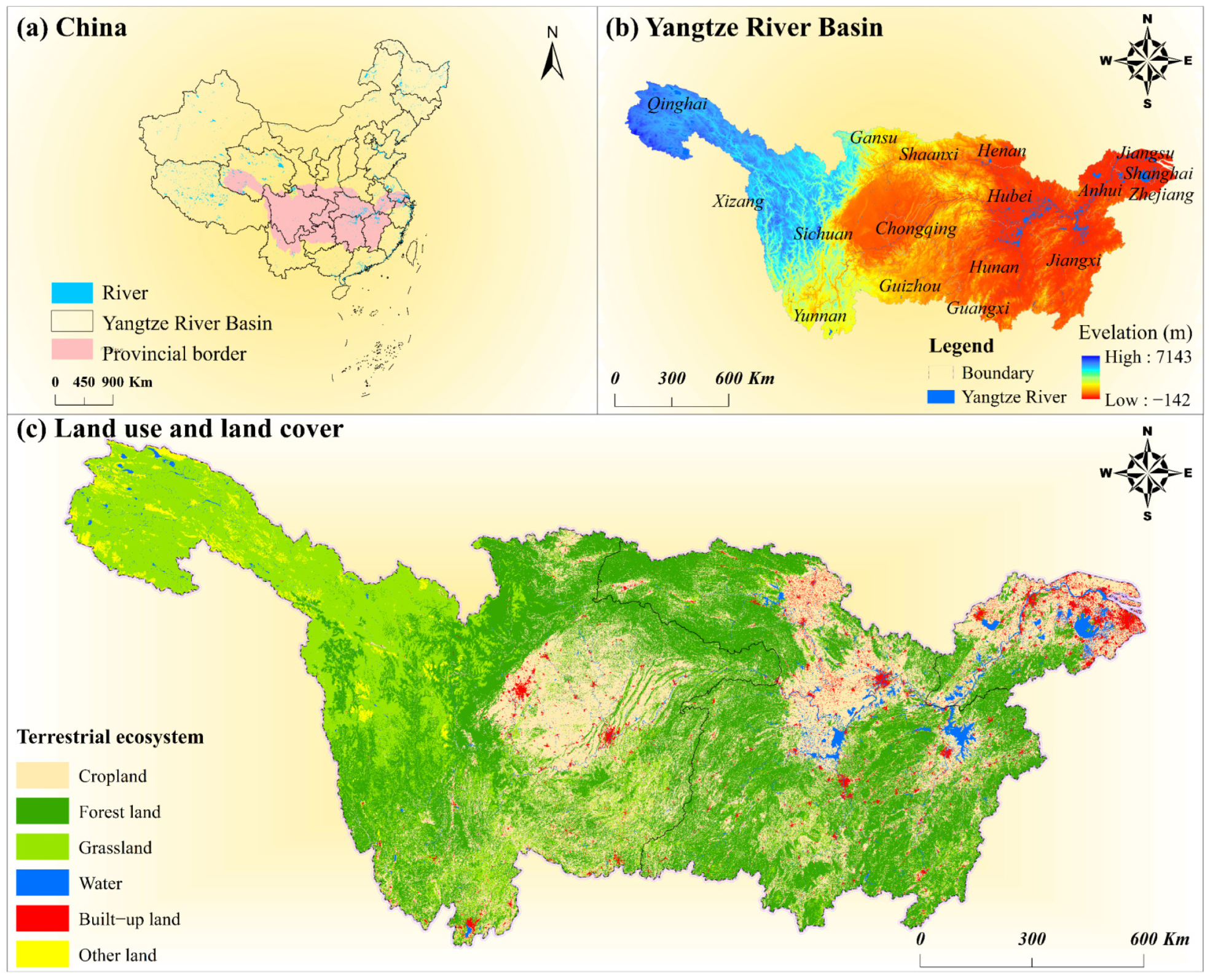
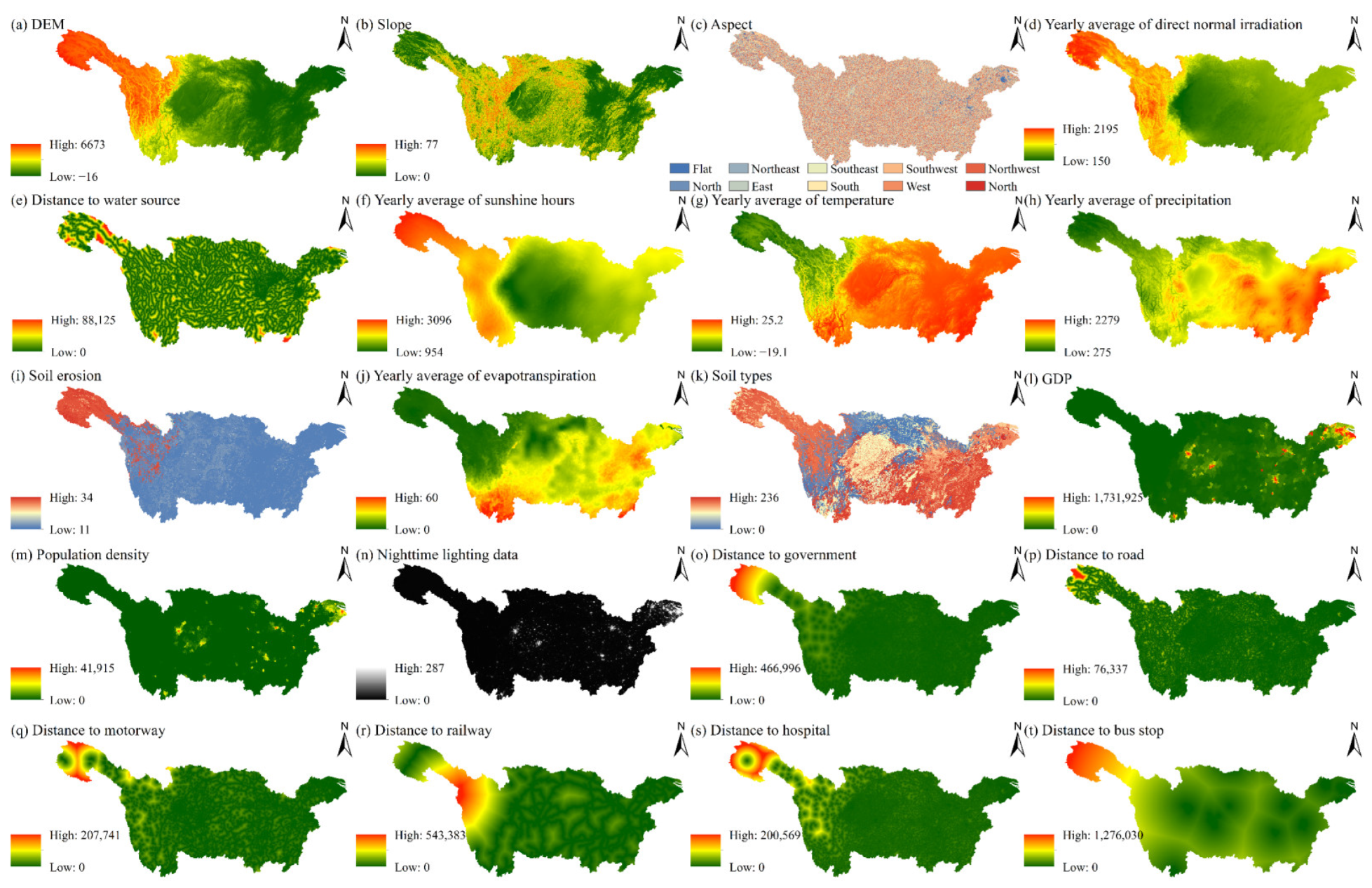


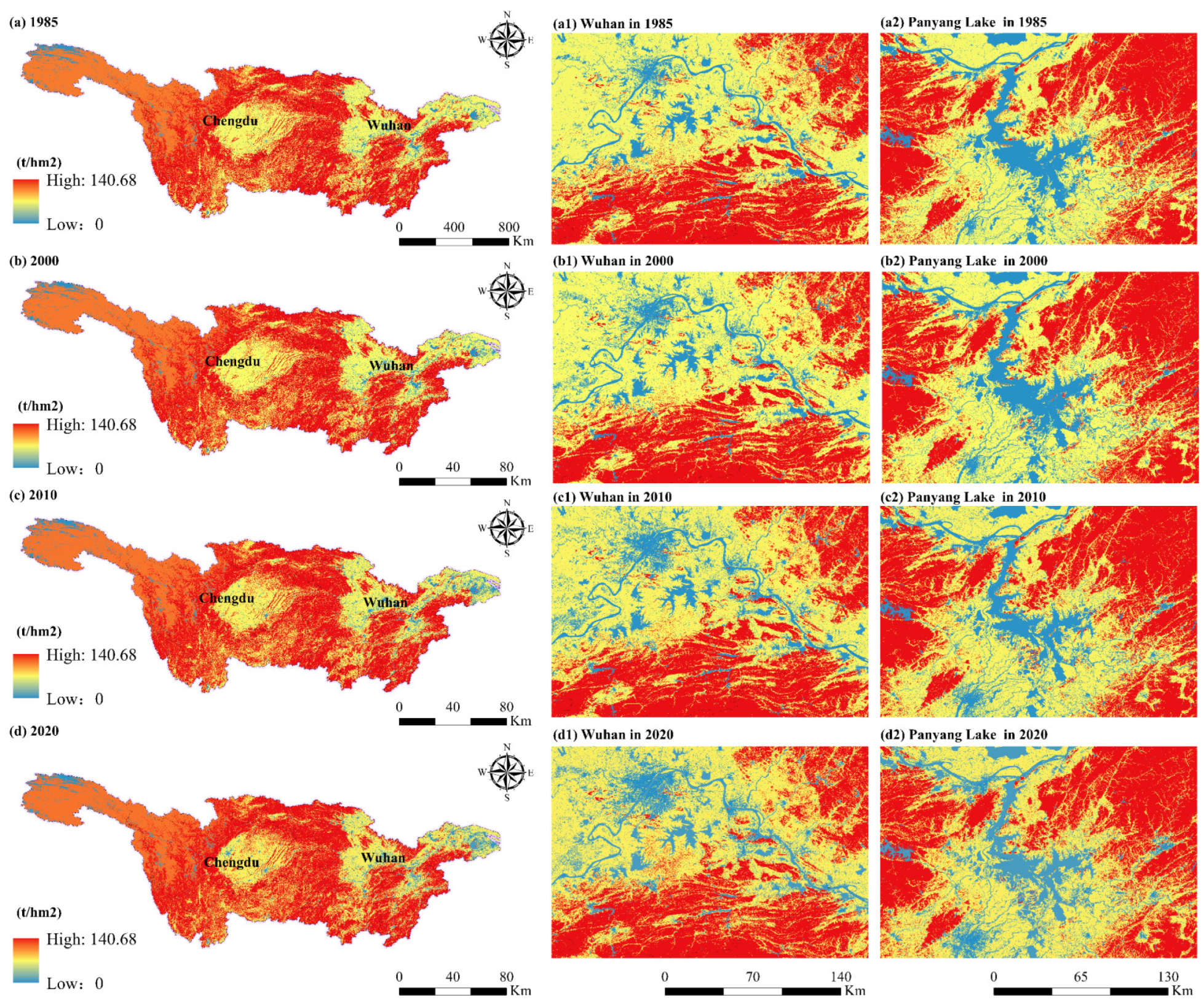
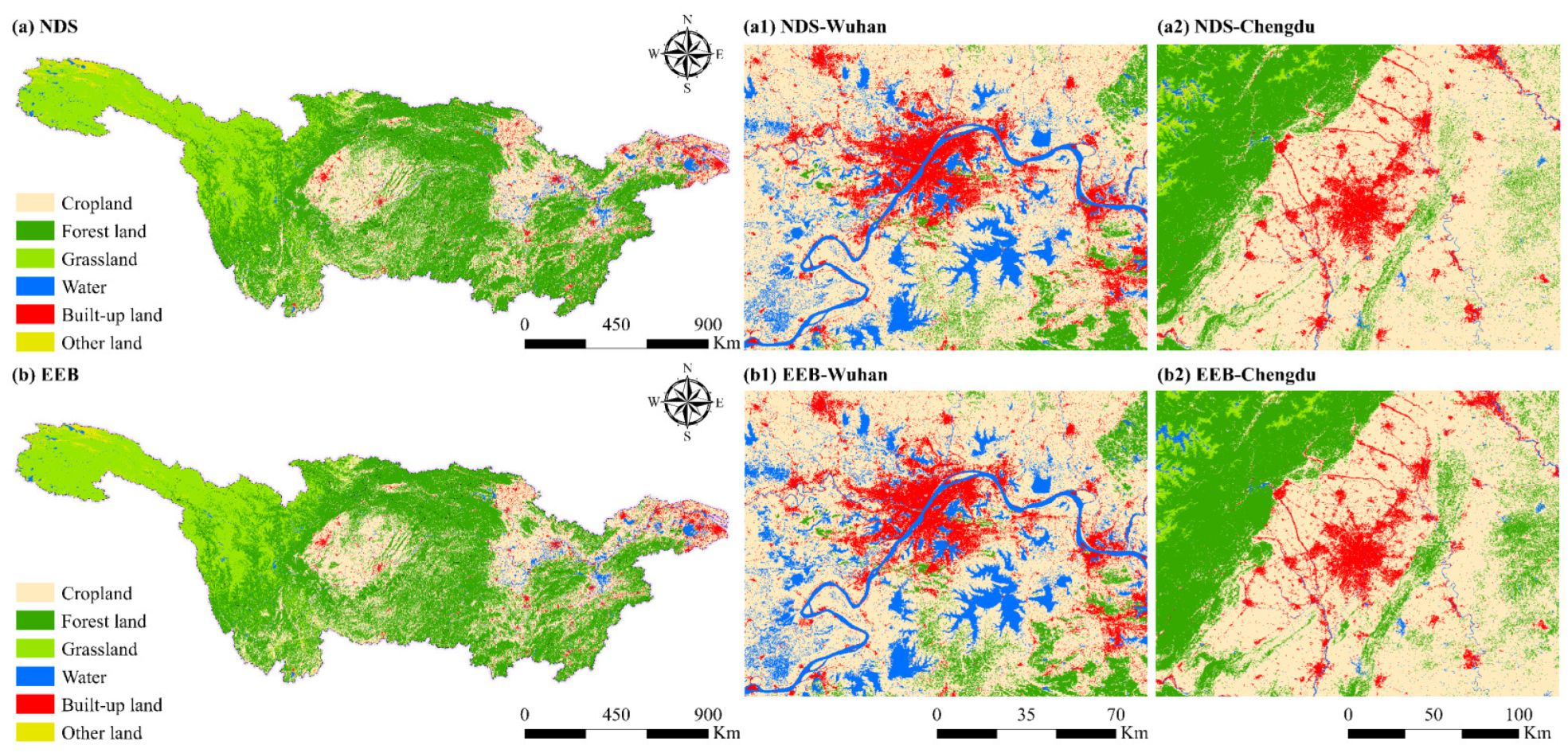

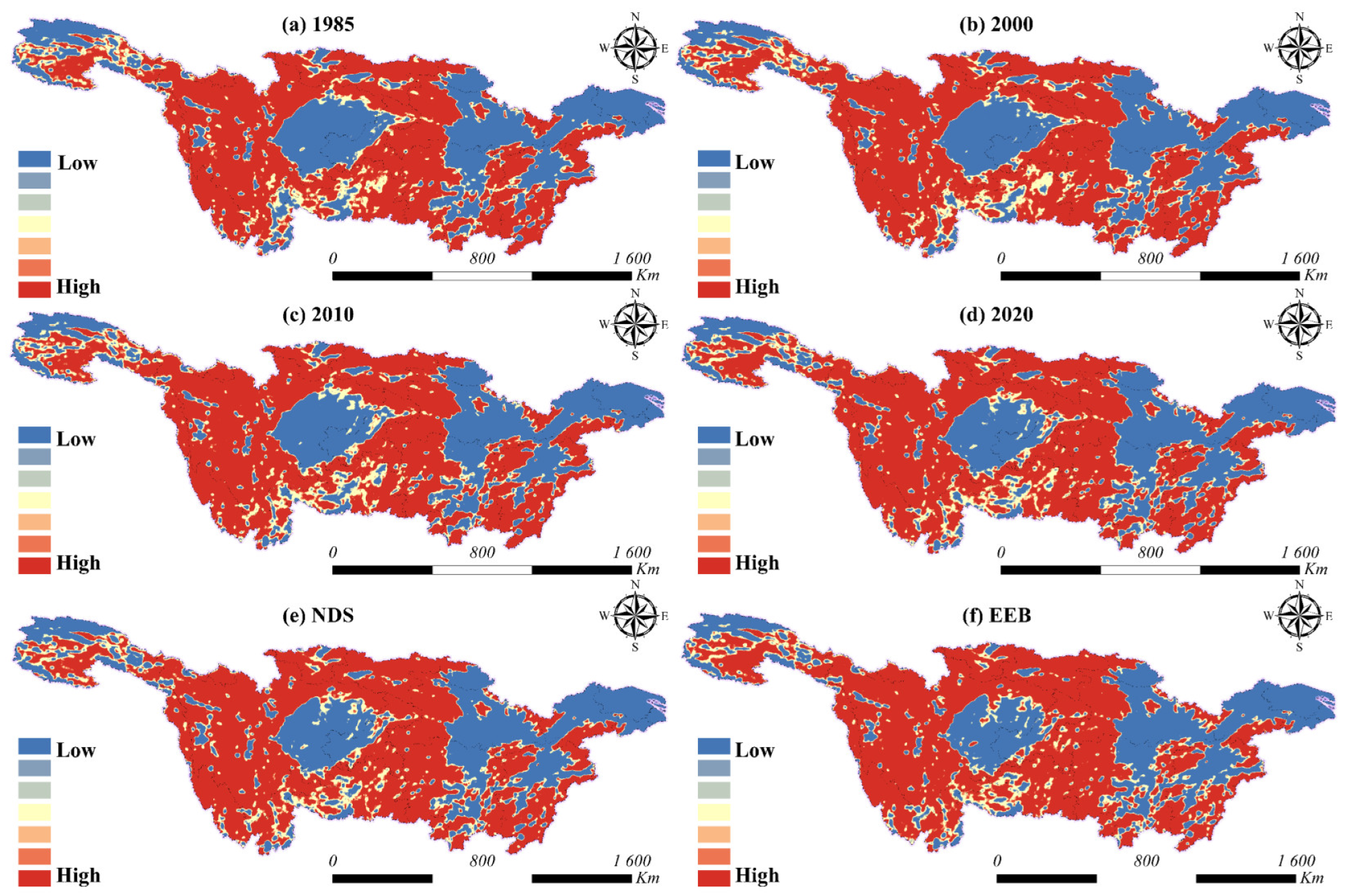

| LEVEL 1 Class | Level 2 Class (Number + Type) | |
|---|---|---|
| LULC Classification | LULC Classification of Resource and Environmental Science Data Center (RESDC) | |
| 1 | Cropland | Paddy fields, dryland, etc. |
| 2 | Forest land | Woodland, shrubland, open woodland, other woodland, etc. |
| 3 | Grassland | High coverage grassland, medium coverage grassland, etc. |
| 4 | Water | Graff, lake, permanent glaciers and snowfields, tidal flats, bottomland, etc. |
| 5 | Built-up land | Urban land, rural residential areas, etc. |
| 6 | Other land | Sandy, gobi, salt marshes, swamp, bare land, and bare rock texture are some of the landscape features, etc. |
| LULC Types | Ci_above | Ci_below | Ci_soil | Ci_dead |
|---|---|---|---|---|
| Cropland | 16.49 | 10.89 | 75.82 | 2.11 |
| Forest land | 30.14 | 6.03 | 100.15 | 2.78 |
| Grassland | 14.29 | 17.15 | 87.05 | 7.28 |
| Water | 1.59 | 0.00 | 64.03 | 3.98 |
| Built-up land | 7.61 | 1.52 | 34.33 | 0.00 |
| Other land | 10.36 | 2.07 | 34.42 | 0.96 |
| Data Type | Category | Time | Resolution | Data Source and Processing |
|---|---|---|---|---|
| Nature climate factors | DEM | 2015 | 30 m | CGIAR-CSI http://srtm.csi.cgiar.org/, accessed on 21 April 2023 |
| Slope | ° | Based on DEM extraction | ||
| Aspect | Based on DEM extraction | |||
| Yearly average direct normal irradiation | 1999–2018 | kWh/m2 | https://www.resdc.cn/, accessed on 11 April 2023 (Soil types are divided into 12 soil orders (e.g., luvisols, semi-luvisols, calcic horizons, etc.), 61 soil groups (yellow cinnamon soil, black soil, chernozem, etc.), and 237 soil subgroups (including arid solonchak, and volcanic ash soil).), accessed on 21 April 2023 | |
| Yearly average sunshine hours | 2021–2022 | Hour | ||
| Yearly average temperature | 1994–2018 | ℃ | ||
| Yearly average precipitation | 1960–2020 | mm | ||
| Yearly average evapotranspiration | 1990–2021 | mm | ||
| Soil types | 1990s | 1 km | ||
| Soil emission types | 1995 | t/(km2 × a) | ||
| Distance to water source | 2021 | m | OpenStreetMap (OSM), https://www.openstreetmap.org/, accessed on 19 April 2023 | |
| Socio- economic factors | Population density | 2020 | person/km2 | https://www.resdc.cn/, accessed on 19 April 2023 |
| Nighttime lighting data | 2020 | 1 km | ||
| GDP | 2020 | ten thousand yuan/km2 | ||
| Distance to government | 2021 | m | OSM, accessed on 19 April 2023 ArcGIS (Euclidean distance) | |
| Distance to road | ||||
| Distance to motorway | ||||
| Distance to railway | ||||
| Distance to hospital | ||||
| Distance to bus stop | ||||
| Restrict conversion | Waterbody | 2020 | km2 | https://www.gscloud.cn, accessed on 19 April 2023 |
| Impervious surface | 2020 | |||
| Cropland land | 2020 |
| LULC (km2) | Cropland | Forest Land | Grassland | Water | Built-Up Land | Other Land |
|---|---|---|---|---|---|---|
| 1985 | 555.47 × 103 | 819.26 × 103 | 353.79 × 103 | 36.70 × 103 | 12.74 × 103 | 20.90 × 103 |
| 1990 | 549.85 × 103 | 821.46 × 103 | 357.07 × 103 | 37.85 × 103 | 14.00 × 103 | 18.64 × 103 |
| 2000 | 543.00 × 103 | 829.27 × 103 | 348.05 × 103 | 39.15 × 103 | 21.43 × 103 | 17.97 × 103 |
| 2010 | 530.11 × 103 | 837.94 × 103 | 338.56 × 103 | 41.80 × 103 | 31.95 × 103 | 18.50 × 103 |
| 2020 | 517.40 × 103 | 845.22 × 103 | 329.85 × 103 | 39.45 × 103 | 44.34 × 103 | 22.61 × 103 |
| 1985–2020 (km2) | Cropland | Forest Land | Grassland | Water | Built-Up Land | Other Land |
|---|---|---|---|---|---|---|
| Cropland | 443.84 × 103 | 68.88 × 103 | 6.48 × 103 | 6.78 × 103 | 29.41 × 103 | 16.95 |
| Forest land | 611.25 × 103 | 752.36 × 103 | –3.76 × 103 | 0.22 × 103 | 1.79 × 103 | 3.36 |
| Grassland | 7.98 × 103 | 23.64 × 103 | 313.96 × 103 | 0.98 × 103 | 0.28 × 103 | 6.94 × 103 |
| Water | 4.23 × 103 | 0.34 × 103 | 0.28 × 103 | 29.67 × 103 | 1.02 × 103 | 1.14 × 103 |
| Built-up land | 0.14 × 103 | 2.72 | 1.33 | 0.82 × 103 | 11.77 × 103 | 0.26 |
| Other land | 14.84 | 9.77 | 5.35 × 103 | 0.96 × 103 | 55.28 | 14.52 × 103 |
| Area | Carbon Storage | Relative Error (RE) | References | |
|---|---|---|---|---|
| Results Simulated by the InVEST Model | Results Calculated by Another Carbon Density Method | |||
| Dongting Lake Basin | 3.16 × 109 t (2020) | 3.07 × 109 t (2020) | 2.93% | Zhou et al. [49] |
| Pingxiang | 5.13 × 107 t (2020) | 5.04 × 107 t (2020) | 1.78% | Hu et al. [50] |
| Hunan | 2.14 × 109 t (2020) | 2.10 × 109 t (2020) | 1.97% | Zhu et al. [51] |
| Year | Above-Ground Carbon Storage (109 t) | Below-Ground Carbon Storage (109 t) | Soil Organic Carbon Storage (109 t) | Dead Organic Matter Carbon Storage (109 t) | Total Carbon Storage (109 t) | Carbon Intensity (t·hm−2) |
|---|---|---|---|---|---|---|
| 1985 | 3.928 | 1.712 | 15.847 | 0.618 | 22.105 | 122.89 |
| 1990 | 3.929 | 1.713 | 15.857 | 0.621 | 22.120 | 122.97 |
| 2000 | 3.933 | 1.694 | 15.838 | 0.616 | 22.081 | 122.76 |
| 2010 | 3.934 | 1.671 | 15.799 | 0.610 | 22.014 | 122.38 |
| 2020 | 3.935 | 1.650 | 15.741 | 0.601 | 21.927 | 121.91 |
| LULC (km2) | YRB NDS | YRB EEB | YRB_U NDS | YRB_U EEB | YRB_M NDS | YRB_M EEB | YRB_L NDS | YRB_L EEB |
|---|---|---|---|---|---|---|---|---|
| Cropland | 506.1 × 103 | 522.7 × 103 | 230.4 × 103 | 231.6 × 103 | 213.3 × 103 | 228.0 × 103 | 62.4 × 103 | 63.1 × 103 |
| Forest land | 849.1 × 103 | 851.8 × 103 | 480.6 × 103 | 497.0 × 103 | 338.2 × 103 | 323.6 × 103 | 30.2 × 103 | 31.0× 103 |
| Grassland | 322.1 × 103 | 329.8 × 103 | 321.8 × 103 | 329.4 × 103 | 3.5 × 103 | 384.4 | 66.4 | 7.41 |
| Water | 37.8 × 103 | 42.1 × 103 | 13.4 × 103 | 11.8 × 103 | 18.4 × 103 | 19.2 × 103 | 10.8 × 103 | 11.1 × 103 |
| Built-up land | 56.2 × 103 | 48.7 × 103 | 10.6 × 103 | 9.9 × 103 | 21.8 × 103 | 20.8 × 103 | 19.0 × 103 | 18.0 × 103 |
| Other land | 27.7 × 103 | 3.9 × 103 | 27.6 × 103 | 3.8 × 103 | 47.54 | 32.38 | 13.40 | 13.39 |
| Year | Above-Ground Carbon Storage (109 t) | Below-Ground Carbon Storage (109 t) | Soil Organic Carbon Storage (109 t) | Dead Organic Matter Carbon Storage (109 t) | Total Carbon Storage (109 t) | Carbon Intensity (t·hm−2) |
|---|---|---|---|---|---|---|
| NDS | 3.932 | 1.630 | 15.675 | 0.595 | 21.858 | 121.507 |
| EEB | 3.948 | 1.657 | 15.815 | 0.604 | 22.024 | 122.423 |
| 1985 | 1990 | 2000 | 2010 | 2020 | NDS | EEB | |
|---|---|---|---|---|---|---|---|
| Moran’s I | 0.65 | 0.66 | 0.65 | 0.66 | 0.67 | 0.67 | 0.67 |
| P | 0 | 0 | 0 | 0 | 0 | 0 | 0 |
| Z | 4648.71 | 4700.05 | 4694.70 | 4760.09 | 4772.34 | 4829.71 | 4826.87 |
| Year | C (109 t) | C-U (109 t) | C-M (109 t) | C-L (109 t) | La | La-U | La-M | La-L | Time | PI | PI-U | PI-M | PI-L |
|---|---|---|---|---|---|---|---|---|---|---|---|---|---|
| 1985 | 22.11 | 13.48 | 7.28 | 1.35 | 231.133 | 221.902 | 239.997 | 270.014 | / | / | / | / | / |
| 1990 | 22.12 | 13.50 | 7.29 | 1.33 | 231.087 | 222.002 | 239.640 | 271.181 | 1985–1990 | −2.273 | 3.292 | −0.923 | −5.945 |
| 2000 | 22.08 | 13.51 | 7.26 | 1.31 | 231.569 | 222.142 | 240.453 | 272.094 | 1990–2000 | −0.867 | 1.175 | −1.213 | −1.818 |
| 2010 | 22.01 | 13.50 | 7.23 | 1.28 | 231.993 | 221.869 | 241.72 | 274.611 | 2000–2010 | −1.731 | 0.602 | −0.784 | −2.459 |
| 2020 | 21.93 | 13.49 | 7.18 | 1.26 | 232.434 | 221.174 | 243.284 | 279.691 | 2010–2020 | −1.912 | 0.236 | −1.069 | −1.139 |
| NDS | 21.86 | 13.47 | 7.17 | 1.22 | 232.763 | 216.962 | 243.391 | 282.003 | 2020-NDS | −2.255 | 0.078 | −3.167 | −3.840 |
| EEB | 22.02 | 13.56 | 7.19 | 1.27 | 233.081 | 222.852 | 245.534 | 280.414 | 2020-EEB | 0.668 | 0.684 | 0.151 | 3.070 |
Disclaimer/Publisher’s Note: The statements, opinions and data contained in all publications are solely those of the individual author(s) and contributor(s) and not of MDPI and/or the editor(s). MDPI and/or the editor(s) disclaim responsibility for any injury to people or property resulting from any ideas, methods, instructions or products referred to in the content. |
© 2024 by the authors. Licensee MDPI, Basel, Switzerland. This article is an open access article distributed under the terms and conditions of the Creative Commons Attribution (CC BY) license (https://creativecommons.org/licenses/by/4.0/).
Share and Cite
Jiang, Y.; Ouyang, B.; Yan, Z. The Response of Carbon Storage to Multi-Objective Land Use/Cover Spatial Optimization and Vulnerability Assessment. Sustainability 2024, 16, 2235. https://doi.org/10.3390/su16062235
Jiang Y, Ouyang B, Yan Z. The Response of Carbon Storage to Multi-Objective Land Use/Cover Spatial Optimization and Vulnerability Assessment. Sustainability. 2024; 16(6):2235. https://doi.org/10.3390/su16062235
Chicago/Turabian StyleJiang, Yuncheng, Bin Ouyang, and Zhigang Yan. 2024. "The Response of Carbon Storage to Multi-Objective Land Use/Cover Spatial Optimization and Vulnerability Assessment" Sustainability 16, no. 6: 2235. https://doi.org/10.3390/su16062235





